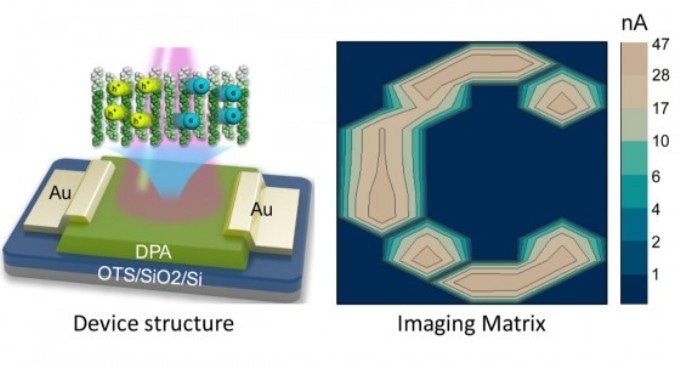Jan 9 2019
Several future applications, such as optical communication, imaging, and biomedical sensing, are crucially dependent on the conversion of light into electrical signals.
 The high sensitivity of the fabricated DPA-OPT (left) was proven by recording spatially resolved current maps using shadow masks (for example, letter “C,” right). (Image credit: Macmillan Publishers Limited, part of Springer Nature)
The high sensitivity of the fabricated DPA-OPT (left) was proven by recording spatially resolved current maps using shadow masks (for example, letter “C,” right). (Image credit: Macmillan Publishers Limited, part of Springer Nature)
At present, scientists from the University of Münster have created an innovative molecular device that enables the detection of light and translating it to detectable electronic current with high efficiency. The study has been reported in the recent issue of the Nature Communications journal.
Phototransistors are crucial electronic building units that allow light to be captured and converted into electric signal. When it comes to future applications like foldable electronic devices, organic phototransistors (OPTs) gain considerable attention owing to their attractive properties, such as lightweight, flexibility, ease of large-area processing, low cost, and precise molecular engineering. To date, the development of OPTs is still lagging behind that of hybrid or inorganic materials, specifically because the low mobility of a majority of the organic photoresponsive materials affects the efficiency of transporting and collecting charge carriers.
Led by Professor Dr Harald Fuchs, scientists from the Physical Institute and Center for Nanotechnology (CeNTech) in Münster have collaborated with colleagues from China and have currently developed innovative thin-film OPT arrays. Their technique is based on a small-molecule—2, 6-diphenylanthracene (DPA). This semiconducting core of this molecule is a strong fluorescence anthracene, where phenyl groups are positioned at 2 and 6 positions of the anthracene to balance the optoelectronic properties and mobility. The fabricated small-molecule OPT device exhibits high photoresponsivity, photosensitivity, and detectivity.
The reported values are all superior to state-of-the-art OPTs and among the best results of all previously reported phototransistors to date. At the same time, our DPA-based OPTs also show high stability in the air.
Dr Deyang Li.
By combining our experimental data with atomistic simulation, we are, in addition, able to explain the high performance of our device, which is important for a rational development of these devices.
Dr Saeed Amirjalayer, University of Münster.
The WWU scientists believe that, therefore, DPA opens the door for high-performance OPTs for basic research as well as practical applications like data transfer or sensor technology.
The study was funded by the German Research Foundation (SFB 858 und TRR 61).